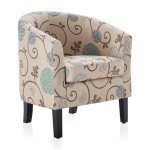Back Support Chairs for the Living Room: Comfort and Ergonomics
The living room is often the heart of the home, a space for relaxation, entertainment, and spending time with family and friends. Choosing the right furniture is crucial for creating a comfortable and inviting atmosphere. While aesthetics play a significant role, prioritizing back support is just as important, especially when selecting chairs. Back support chairs in the living room can contribute significantly to long-term spinal health and overall well-being. These chairs are designed to promote proper posture, reduce strain on the back muscles, and alleviate discomfort associated with prolonged sitting.
The importance of ergonomic design in living room furniture has gained increased recognition as people spend more time indoors, often engaging in sedentary activities such as watching television, reading, or working remotely. Chairs that lack adequate back support can lead to poor posture, which in turn can result in chronic back pain, stiffness, and even more serious spinal issues over time. Investing in chairs that prioritize back support is therefore a proactive step toward maintaining a healthy and comfortable lifestyle.
Several factors contribute to the effectiveness of a back support chair. These include the lumbar support, the chair's height and adjustability, the seat depth and angle, and the overall construction materials. Each of these elements plays a vital role in ensuring that the chair conforms to the body's natural curves and provides adequate support where it is needed most. Understanding these features and how they contribute to spinal health is essential when selecting the right back support chair for your living room.
Understanding Lumbar Support
Lumbar support is perhaps the most critical feature of a back support chair. The lumbar region, located in the lower back, is particularly susceptible to strain and injury due to the natural curvature of the spine. A chair with proper lumbar support will provide targeted cushioning and alignment to this area, helping to maintain the spine's natural "S" curve. This reduces stress on the spinal discs and surrounding muscles, preventing pain and discomfort.
Different chairs offer varying degrees and types of lumbar support. Some chairs feature a fixed lumbar cushion, while others offer adjustable lumbar support that can be customized to the individual's body shape and preferred level of firmness. Adjustable lumbar support allows users to fine-tune the chair to their specific needs, ensuring optimal comfort and spinal alignment. The material used for the lumbar support cushion can also vary, ranging from foam to gel or even inflatable air bladders. Each material offers a different level of support and comfort, so it's important to consider personal preferences when choosing a chair.
The shape and placement of the lumbar support are also crucial factors. A well-designed lumbar support cushion will contour to the natural curve of the lower back, providing consistent and even support. It should not be too high or too low, as this can actually exacerbate back pain. Ideally, the lumbar support should be positioned so that it fills the gap between the chair and the lower back when the user is seated. The size of the support should also be proportional to the person's size and build. A chair with lumbar support that is too small or too large may not provide adequate benefits. Some manufactures offers chairs with "adaptive" lumbar support systems where the back rest will change and adjust to the user's back as they move or shift positions.
When evaluating a chair's lumbar support, it's important to sit in the chair for an extended period to assess its comfort and effectiveness. Pay attention to how your lower back feels after sitting for a while. Is there any pressure or discomfort? Does the chair seem to be promoting proper posture? If possible, try adjusting the lumbar support to see if it can be further improved. A chair that offers customizable lumbar support is more likely to provide a comfortable and supportive seating experience.
Chair Height, Adjustability, and Seat Design
Beyond lumbar support, the chair's height and adjustability are critical for ensuring proper ergonomics. The ideal chair height allows the user to sit with their feet flat on the floor and their knees bent at a 90-degree angle. This position promotes healthy blood circulation and reduces strain on the lower back and legs. If the chair is too high, the user's feet will dangle, which can lead to poor posture and discomfort. If the chair is too low, the user's knees will be raised, which can also strain the back.
Adjustable chair height is a valuable feature that allows users to customize the chair to their specific needs and body size. Many chairs offer pneumatic height adjustment, which allows for easy and precise height modifications. Some chairs also feature adjustable armrests and backrests, further enhancing customization options. Adjustable armrests can help to reduce strain on the shoulders and neck, while an adjustable backrest can allow the user to fine-tune the chair's lumbar support and overall comfort.
The seat depth and angle are also important considerations. The seat depth should be sufficient to support the user's thighs without placing excessive pressure on the back of the knees. A seat that is too deep can cause the user to slouch forward, which can strain the lower back. A seat that is too shallow may not provide adequate support for the thighs. The seat angle should be slightly tilted forward to encourage proper posture and reduce pressure on the tailbone. Some chairs offer adjustable seat angle, allowing users to further customize the chair's ergonomics. A waterfall seat edge, which slopes downward, can also improve comfort by reducing pressure on the back of the knees and promoting better circulation.
The chair's base and stability also play a role in its overall comfort and support. A wide, stable base is essential to prevent the chair from tipping over, especially when the user is leaning back or reaching for something. Most office chairs feature a five-star base with casters, which allows for easy movement and maneuverability. However, for living room chairs, a more traditional four-legged base may be preferred for aesthetic reasons. Regardless of the base design, it's important to ensure that the chair is stable and well-balanced.
Construction Materials and Overall Design
The materials used in the construction of a back support chair can significantly impact its comfort, durability, and overall appearance. The frame of the chair should be made of a sturdy, durable material such as hardwood or steel. These materials can withstand the rigors of daily use and provide long-lasting support.
The cushioning material should be comfortable and supportive. High-density foam is a popular choice for chair cushions, as it provides excellent support and retains its shape over time. Gel-infused foam is another option, as it offers enhanced pressure relief and temperature regulation. The upholstery material can also affect comfort and breathability. Leather, fabric, and mesh are all common upholstery options, each with its own advantages and disadvantages. Leather is durable and stylish but can be expensive and less breathable than fabric or mesh. Fabric is comfortable and comes in a wide variety of colors and patterns, but it can be more prone to staining than leather. Mesh is highly breathable and ideal for warm climates but may not be as comfortable as fabric or leather for some users.
The overall design of the chair should also be considered. A chair with a high back can provide additional support for the upper back and neck, while a chair with a lower back may be more suitable for smaller spaces. The chair's style should also complement the overall decor of the living room. There are many different styles of back support chairs available, ranging from traditional to modern, so it's important to choose a chair that fits your personal taste and complements your existing furniture.
The armrests are another important design element. Armrests can provide additional support for the arms and shoulders, reducing strain on the neck and upper back. The armrests should be positioned at a comfortable height, typically around elbow level. Some chairs offer adjustable armrests, allowing users to customize the height and position to their specific needs. Padded armrests can also improve comfort and reduce pressure points.
Finally, consider the chair's weight capacity. Most chairs have a maximum weight limit, which is typically listed in the product specifications. It's important to choose a chair that can safely support your weight, as exceeding the weight limit can damage the chair and potentially cause injury.
In conclusion, selecting the appropriate back support chair for your living room is an investment in long-term health and well-being. By carefully considering factors such as lumbar support, adjustability, seat design, construction materials, and overall design, you can find a chair that provides optimal comfort and promotes proper posture. While aesthetics are important, prioritizing ergonomics is essential for creating a living room that is both stylish and supportive.

High Back Accent Chair With Lumbar Pillow Linen Upholstered Armchair For Living Room Office Teal Walmart Com

Floguor Indoor Floor Gaming Chair Back Support Bahrain Ubuy

Best Ergonomic Living Room Chairs Recliners And Sofas 2024 Edition Trends

Kislot Recliner Chair For Adults Push Back Armchair Home Theater Seating With Lumbar Support Single Sofa Living Room Shopstyle

Angelic Oakwood 1 Seater Sofa With Cushion

Chinese Living Room Outdoor Floor Chairs With Back Support Leisure Seat Made In Com

High Back Living Room Chair Modern Accent With Lumbar Pillow Teddy Velvet Fabric Upholstered Armchair Headrest For Bedroom

Larsen Lounge Chairs Supportive Armchairs Comfortable Seating

The Ergonomic Sofa New York Times

Floor Folding Chairs Sofa 14 Position Adjustable Recliner Portable Padded Lounge Chair For Bedroom Home Pets Lazy Sleeper Gaming Cool Stuff Room Free Shipping








